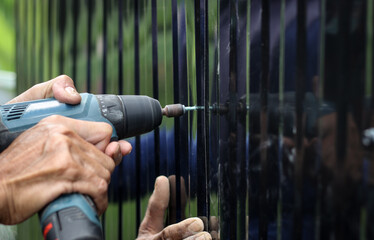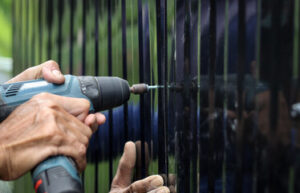Fence Installation – How to Get Your Fence Up and Running in No Time

Building a fence is a time-consuming project. During the summer, fence contractors and material vendors experience backlogs due to city permitting delays and busy schedules. To make the process as smooth as possible, homeowners should prepare their yards before beginning construction. This includes clearing obstacles and staking out property lines. Fence Installation Anchorage AK also involves contacting utility companies to check for buried utility lines.
 Fence installation costs depend on the type of fence you choose, its materials, and how large a space it needs to cover. Depending on these factors, a typical backyard fence can cost between $1,330 and $5,550. If you have a larger yard or more premium materials, the cost can go up to $10,000. You should also factor in landscaping and lighting fixtures, which can add to the final cost.
Fence installation costs depend on the type of fence you choose, its materials, and how large a space it needs to cover. Depending on these factors, a typical backyard fence can cost between $1,330 and $5,550. If you have a larger yard or more premium materials, the cost can go up to $10,000. You should also factor in landscaping and lighting fixtures, which can add to the final cost.
Most fence companies offer free estimates for their services. The estimate includes evaluating your property, including any obstacles to installing the fence. If you have any trees or bushes that block the path of the fence, you will need to remove them. Your fence company may do this for an additional charge, or you can hire a tree service to do it for you.
Another factor affecting the fence installation cost is its length and height. Taller and longer fences require more materials, increasing the foot price. Additionally, you will need to pay for the cost of gates and hardware. If you are building a fence in a shared space, be sure to check with your neighbors to make sure that they are happy with the idea. You will also need to check the neighborhood rules regarding fences and whether you need a permit to build one.
The price of fencing depends on the size of your yard, the style and material used, the height of the fence, and the number of gates. The cost will also vary based on the terrain, as the ground must be graded and rocks removed before the fence can be built. In addition, if the property has a significant slope, you will need to pay for extra labor to build the fence.
A wooden fence typically costs around $25 – $35 per foot to install, while a vinyl picket fence will run you between $30 and $55 per foot. This is due to the fact that a vinyl fence is not prone to rust like a wood fence.
Many homeowners choose to install fences to provide privacy and security to their property. Fences can also add aesthetic value, especially if they’re made from solid wooden materials or vinyl or wrought iron. In addition, fences can prevent wildlife from accessing your yard or garden and protect your children and pets. However, a fence is only effective if it’s properly installed.
Before starting any fence installation project, you should gather the necessary materials. Most of these items are available at local home improvement stores or lumberyards. Alternatively, you can order them online or buy them from a specialized fence company. In either case, make sure to select materials that are galvanized to resist rust.
One of the most important elements of a fence is the post. A good quality post will help ensure that the entire fence is sturdy and will last for decades. You can purchase a prefabricated fence that has the posts already attached, or you can install them yourself. In either case, you need to make sure that the posts are seated correctly and at a consistent height.
You can use a torpedo level or spirit level to check if the fence is properly level. A post hole auger, or digger, is another tool you’ll need for digging holes for your fence posts. This tool will save you a lot of time and effort and will also allow you to dig holes that are uniform in size. If you don’t have one, you can rent them from most equipment rental outlets.
Before you start building, it’s essential to locate and mark any buried utility lines on your property. This will prevent you from accidentally cutting into a gas line, water main or cable while working on your project. You can call the local utilities companies to find out where their lines are located before digging.
Once you’ve marked the location of your fence, clear away any debris and vegetation. You should also draw a map of the site to help you plan where each post will go. Using a mason’s line, outline where you’ll need to dig each post. Mark the locations with a spray can of orange paint (or garden stakes).
Before you begin constructing your fence, prepare the ground by adding gravel to it. This will allow water to drain easily during wet weather, extending the life of your fence. Ideally, you should use pea-sized landscaping gravel for this purpose.
If you’re considering installing a fence in your yard, it’s important to understand the installation process and prepare properly before you head to the home improvement store to purchase materials. This will help you save money and ensure the quality of your project. In addition, proper planning will also help avoid misunderstandings between you and your contractor.
Start by determining the primary purpose of your fence. This will help you choose a style and materials that best fit your needs. For example, if you’re looking for privacy, it might be worth spending the extra money on more expensive materials. However, if you’re just trying to contain pets or children, a less expensive design might suffice.
Once you’ve determined the purpose of your fence, the next step is to mark out where it will go on your property line. This can be done using stakes or string and is a good way to avoid mistakenly building your fence over your neighbors’ land. You should also check your deed to see if there are any easements that might limit the placement of the fence.
Fence post holes are the foundation for your fence, and it’s important to dig them correctly. Ideally, they should be set below the frost line to prevent shifting or collapsing due to winter weather. This is especially true in colder climates. If you’re unsure where to place fence posts, consult with your local building inspector for advice.
During the planning process, it’s also important to consider the location of any gates or transition points. These will determine how long your fence is and how it will be built. In addition, it’s a good idea to create a site plan that shows how your fence will be constructed along your property line. This will ensure that your fence complies with all local laws and codes, including height restrictions.
When constructing the fence, it’s important to use high-quality materials and follow all construction guidelines. This will help ensure that your new fence is sturdy and lasts for years to come. A high-quality fence is also an investment that will add value to your property.
Fences are a useful addition to homes, providing privacy and security. They also help keep pets and children safe from busy streets and nosy neighbors. They can be installed in a variety of styles, from simple to elaborate. They can even include gate options, which are especially useful for keeping pets in and out of the yard. Regardless of the type of fence you choose, there are several steps that must be taken to ensure the proper installation.
When installing a fence, you must first locate and mark the property line. This is important, as it will determine the size of the fence. It is also necessary to identify any utility lines that might be impacted by the construction of the fence. Some communities have laws regarding the maximum height of a fence, and it is essential to find out this information before beginning the construction process.
The next step in the fencing installation process is digging the fence post holes. This will usually take a crew of two or three people with handheld post hole diggers. It is important to dig these holes deep enough to ensure that they will not be susceptible to frost heaves. This is particularly true in areas with cold weather conditions.
After the posts are in place, a crew will install the horizontal stringers and vertical fence boards. This part of the process is where the fence really begins to take shape and develop its defining character. Fence panels can be purchased in a variety of colors, finishes, and designs, and they are easy to install. Pickets, which are individual fence boards that create space in between them, can also be used to create a traditional white picket fence look.
Once the vertical and horizontal components of the fence are in place, a crew will set the concrete for the posts. This will take a few hours to dry and cure. Once the concrete has dried, a crew will attach the fence posts to the rails and splice the posts to ensure that they are secure.
After the fence is complete, it is a good idea to apply a coat of sealer or stain to the wood. This will protect the fence and keep it looking new for a long time.
